What Is the Best Sheep Breed for Wool?
If you’re planning on breeding sheep for their wool, it’s important that you know which sheep breeds are the best for producing the type of wool that you desire. I’ve researched all types of sheep breeds so I can help you decide which one is right for you.
So, what is the best sheep breed for wool? The best sheep breed for wool depends upon the intended use for the wool. Sheep breeds such as the Booroola Merino, Delaine-Merino, Panama, Rambouillet, and American Cormo produce fine wool that can sell for a high price. Other popular sheep breeds for wool include Blue Faced Leicester, Corriedale, Lincoln, and Romneys.
Read on to learn which sheep breeds are best suited for producing the type of wool that is the most valuable for your needs.
Determining the Best Sheep for Wool for Your Needs
With so many sheep breeds to choose from, determining the right breed for your wool needs can feel overwhelming. I’ve broken down the most popular sheep breeds for wool in the table below to help you make the best decision:
| Sheep Breed | Wool Quality | Wool Length | Best Suited For |
| Booroola Merino | Fine, Micron 18-23 | 3-4” | Close-to-body & odor-resistant garments |
| Delaine-Merino | Fine, Micron 17-22 | 2 1/2 – 4″ | Close-to-body & odor-resistant garments |
| Panama | Micron 25-30 | 3-5″ | Knitwear and socks |
| Rambouillet | Micron 18.5-24.5 | 2-4″ | Close-to-body & gentle knitwear garments |
| American Cormo | Micron 17-23 | 2 1/2 – 4″ | Close-to-body garments |
| Blue Faced Leicester | Micron 24-28 | 3-6” | Knitwear and socks |
| Corriedale | Micron 24.5-31.5 | 3.5-6″ | Knitwear and socks |
| Lincoln | Micron 33.5-41 | 8-15″ | Rugs, upholstery, tapestry weaving |
| Romney | Micron 29.30-36.29 | 5-8″ | Hand-spinning and rugs |
Top Sheep Breeds for Wool
Booroola Merino 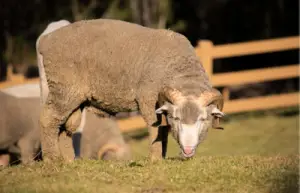
- Wool Quality – Fine, Micron 18-23
- Wool Length – 3-4″
- Uses – Close-to-body & odor-resistant garments
Booroola Merino is a strain of Merino sheep that originated in Australia. The Booroola Merino was imported into the United States and is now a highly popular breed of sheep for wool due to the density and quality of its wool, as well as the rate at which the sheep reproduces.
A fully developed Booroola Merino is an impressive sight to behold. With wool covering their bodies from head to toe, an all-white face, and horns emerging from their thick wool, Booroola Merino are beautiful sheep with incredibly valuable fleece.
Originally developed in New South Wales, Australia, Booroola Merino can now be found all around the world. With excellent foraging abilities, these sheep are capable of thriving in almost any climate.
Delaine-Merino 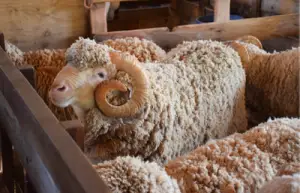
- Wool Quality – Fine, Micron 17-22
- Wool Length – 2 1/2 – 4″
- Uses – Close-to-body & odor-resistant garments
Delaine-Merino’s are another very popular breed of sheep for wool due to the quality of their wool, how quickly they reproduce, and their ability to thrive in most conditions. They are raised primarily for wool production.
Delain Mernion’s have large curling horns, and bodies covered in thick, white wool. A distinct attribute of Delaine-Merino sheep as opposed to other variations of Merinos is that their bodies don’t typically have wrinkles. However, around their neck, flank, shoulders, and thighs, they often have large folds of skin. These folds are actually a good thing because they enable this breed to produce more wool due to an overall greater surface area.
Delaine-Merino sheep were originally developed in the United States, and are typically found in the Western and Southwestern areas of the US. Some of the states where they are common are California, Texas, and New Mexico. All in all, the Delaine-Merino is great at adapting to their environment, making them an ideal option for sheep farmers desiring high-quality wool.
Panama 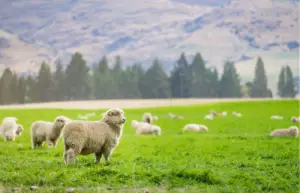
- Wool Quality – Micron 25-30
- Wool Length – 3-5″
- Uses – Knitwear and socks
Originally developed in Idaho, Panama sheep are used for both wool production as well as meat production, making them a versatile option for sheep farmers. Their wool is somewhat courser with thicker fibers than Merino’s, making it better suited for outer knitwear and socks.
Panama sheep are hornless and typically white in color. Their wool is long and thick, and the sheep are fairly large with ewes averaging 180 to 210 pounds, and rams averaging 250 to 280 pounds.
Today, Panama sheep are rare, with, most of them being found in Montana and Idaho. Although they’re rare, they’re known for their ability to survive in harsh environments. Because of this, herds of them can be owned in a wide variety of places.
Rambouillet 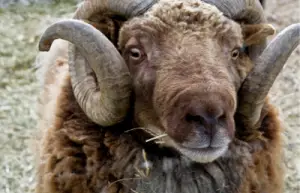
- Wool Quality – Micron 18.5-24.5
- Wool Length – 2-4″
- Uses – Close-to-body & gentle knitwear garments
Rambouillet sheep are well known the world over for their high-quality wool and meat, making them another versatile sheep breed to own. The breed was started in 1786 in France, and the US Rambouillet Association was eventually formed in 1889.
One valuable trait of Rambouillet sheep is that they are the largest of the fine wool-producing sheep breeds. As for appearance, they have white legs and faces, they are large in stature, and ewes and rams both have horns.
Rambouillet sheep are also known for their strength and ability to handle almost any climate with ease. They are most often found on the western ranges of the United States.
American Cormo 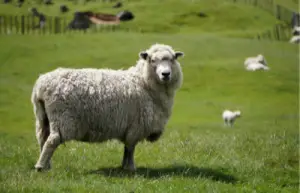
- Wool Quality – Micron 17-23
- Wool Length – 2 1/2 – 4″
- Uses – Close-to-body garments
American Cormo sheep originated in Tasmania, Australia, but were later imported into the United States in 1976. One of the best qualities of this breed of sheep is that they can be a very cost-effective breed for producing wool because they are able to live on a smaller amount of food than most other breeds of sheep.
The American Cormo sheep breed lacks horns, are primarily white in color, and has faces unobscured by wool. They are considered neither large nor small in comparison with other breeds of sheep.
Like many other sheep breeds, the American Cormo is capable of living in a large variety of environments. Having originated in Australia, this breed can still be most commonly found in South-Eastern Australia.
Blue Faced Leicester 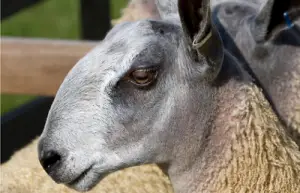
- Wool Quality – Micron 24-28
- Wool Length – 3-6”
- Uses – Knitwear and socks
The most distinctive trait of Blue Faced Leicester sheep is their noses that have dark blue skin visible through their white hair. This sheep breed originated in the United Kingdom in the 18th century and was exported to Canada in the 1970s. While this breed is typically raised for their meet, in recent years demand for their wool has started to increase due to its valuable traits for hand spinning.
Bluefaced Leicester sheep have fine and curly wool and are primarily white in coloration, although some of them have brown faces. Neither ewes or rams of this breed have horns. Their legs, head, face, and stomach areas are all free of wool.
Blue Faced Leicester sheep are hardy and do well in climates similar to their native environment. Today, you can typically find this breed in Wales, Scotland, and England.
Corriedale 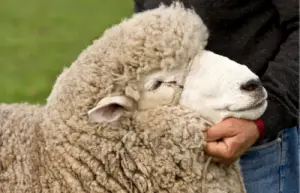
- Wool Quality – Micron 24.5-31.5
- Wool Length – 3.5-6″
- Uses – Knitwear and socks
Corriedale sheep were first developed in New Zealand in the late 1800s, and in 1914 they were imported into the United States. This breed is highly popular, second only to the famous Merino. Another dual-purpose sheep breed, Corriedale sheep can be raised for the production of both wool and meat.
Corriedale sheep can have both light and dark wool, are larger in size than many other sheep breeds and are usually polled.
The breed of sheep can be found all over the world. The largest concentration of them can be found in North America, South America, South Africa, and Asia. They are adapted to ranges as well as farms.
Lincoln 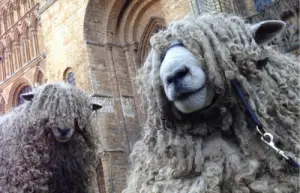
- Wool Quality – Micron 33.5-41
- Wool Length – 8-15″
- Uses – Rugs, upholstery, tapestry weaving
Lincoln sheep were developed in England and were first imported into the US in the 18th century. Although Lincoln sheep aren’t as popular as other breeds of sheep, they’re valued by some for their long and thick wool.
With average weights well in excess of many other sheep breeds, Lincoln sheep are often referred to as the largest sheep breed in the world. Their coats are generally thick but are sometimes thin on their legs. There is some debate about recognizing Lincoln sheep that are anything but white. However, you can find them in black, silver, gray, and charcoal as well.
The Lincoln can do well in cold and dry climates. Today, they are mostly found in Britain, Canada, the United States, New Zealand, and Australia.
Romney 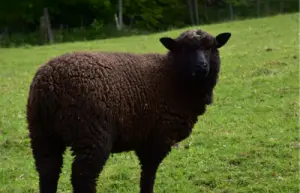
- Wool Quality – Micron 29.30-36.29
- Wool Length – 5-8″
- Uses – Hand-spinning and rugs
Romney’s originated in England and were exported to New Zealand in 1853. This breed is prized for both its wool as well as its meat. One distinct trait that you’ll often hear about the Romney is that they have a resistance to footrot, a disease that can cause lameness in sheep.
Romney sheep can have both white and colored fleece. Their hooves and noses should be black, faces white, and skin color pink.
Romney’s can be found all over the world in various farming environments. They’re most often found in New Zealand, England, California, Australia, Canada, Brazil, and Portugal.
Is Raising Sheep for Wool Profitable?
If you’re thinking of raising sheep for wool, you’re probably wondering, is raising sheep for wool profitable? Raising sheep for wool can be profitable, however, the profit margins are often narrow. It’s recommended that you establish numerous sources of revenue from your sheep by selling their meat, milk, and selling them at a market. Additionally, the quality of the wool will impact its selling price, so ensure you raise sheep that will produce the high-quality wool you need to turn a profit.
Raising sheep is a significant responsibility that requires a significant amount of knowledge in order to be done correctly. Check out these articles for additional information about raising sheep:
- How to Care for Sheep: Ultimate Guide for Beginners
- Understanding Sheep Behavior
- Essential Sheep Terminology
Save this article to your “Sheep” board on Pinterest!

